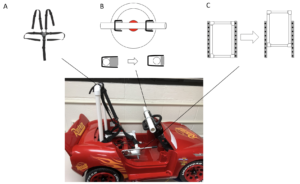On February 20th, the team met to complete the third car build. Here, we were able to finish the novel steering design and finalize the design for the seat frame. The final steering wheel is compressible against two foam blocks to account for limited muscle tone in the arm and bracketed by two U-Brackets to allow for control of steering. The seat frame is coupled to a seat adjuster allowing for forwards and backward motion and a five-point harness is connected directly to the frame to increase safety and adjustability. Below are images of the design schematic and the final products in the car.

An image of a toy car modified to be used by small children with physical and mobile limitations to aid in early cognitive development. This design depicts A)a five-point harness, B)a novel steering and acceleration mechanism and C)a fully adjustable seat frame. All modifications not shown.
From this point moving forward, our team will be aiming to complete the car the week after Spring Break by doing a final car build. Here, we plan to implement the speed controller, insert kickboards with later support foam into the seat frame, and finish the wiring for the button. In addition, we want to move the battery port to the outside of the car so it’s easier to access for the parent. For the seat design, we would ultimately like to implement a mechanism for tilt, although we have not decided on a final design. So far, the leading idea is to have cutouts in the attached kickboard to allow for PVC pipe inserts on either the front end or the back end which would provide tilt and height adjustability. These design ideas can be finalized at the next build.
Our contact from Belmont has informed us that the IRB approval for the Susan Gray School is still in progress and we aim to have the car in the school around the third week of March.







